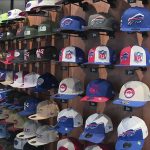Illegal shipments of clothes and fabric from China are cheating the U.S. government out of millions of dollars and costing American workers their jobs, say industry and government sources.
U.S. Customs Service agents seized about $45 million in “wearing apparel” that was shipped illegally or smuggled to the United States last year, a nearly sixfold increase from 2001, the agency said.
The clothing, originating mostly in China, is one of the biggest chunks of property that the Customs Service seizes every year as overseas manufacturers try to slip goods into the country, avoiding quotas and millions of dollars in duties.
The impact of the illegal goods on North American industry is devastating, the industry says.
“It’s costing tens of thousand of textile jobs,” said Cass Johnson, associate vice president for international trade at the American Textile Manufacturers Institute, a D.C. industry group. “It’s a huge problem.”
The seizures are a fraction of the illegal products that make it into the country.
“Were not catching most of what’s going on,” said Janet Labuda, director of the textile enforcement division at the U.S. Customs Office of Field Operations.
Mr. Johnson estimated that billions of dollars in illegal clothes and fabrics make it into the U.S. market. He is worried that the problem will worsen as the United States negotiates and signs more free-trade agreements.
The Bush administration this month proposed that fabric and apparel imports become duty-free in five years as part of a Free Trade Area of the Americas. Trade agreements with Morocco, five countries in southern Africa, five in Central America and Australia also are in the works.
“That is the big concern right now about expanding trade preferences,” Mr. Johnson said. “If we cant even enforce our own borders, how are we going to enforce borders of the entire Western Hemisphere?”
One of the major difficulties is tracing the origin of fabric. U.S. trade agreements usually require foreign manufacturers to use U.S.-made fabrics and yarns when cutting and sewing garments for export back to the United States. Use of U.S. components is the trade-off for market access.
But it is difficult to determine a yarn or fabric’s origin, compromising enforcement efforts.
The government and the industry are turning to technology to combat the smuggling and trans-shipment problem.
The Commerce Department is funding a project at the Oak Ridge National Laboratory in Oak Ridge, Tenn., to assess technologies that could be used in a textile “marker system” that would allow U.S.-origin products to be scanned and identified.
“I think it has the potential for being helpful to the industry,” said James C. Leonard, deputy assistant secretary for textiles and apparel at Commerce. “It’s not going to solve the problem, but it can help.”
The U.S. Agriculture Department is working on a separate but similar program at a research facility in Clemson, S.C. Facility officials were not willing to discuss the project.
The industry is interested in both projects, which would allow the Customs Service to determine whether fabric has been produced at a U.S. facility.
A preliminary report from Oak Ridge is due soon, and a technology prototype could be ready in about a year.
“Ive always believed there is a technology that can support this industry’s need. The key is, is it cost-effective and does it have minimum impact on the conduct of business,” said Glenn Allgood, an Oak Ridge researcher.
The industry is hopeful.
“Were pretty excited about it,” said Mike Hubbard, executive vice president of the American Yarn Spinners Association. “If a product claims to be U.S. and it’s not, that doesnt benefit our companies.”
In the meantime, the Customs Service has stepped up its efforts to seize illegal clothes. But officials there worry that new trade deals in the Americas and Africa will complicate enforcement efforts.
“It makes our job more complex, it makes it harder,” Miss Labuda said.
The increase in seizures — to about $45 million in 2002 from $7.8 million in 2001 — reflects stepped-up enforcement and more illegal products being sent from China, she said.
“Ninety percent of the problem is China,” Miss Labuda said.
Some of goods are smuggled outright into the United States, and some are trans-shipped illegally — made in China, sent to another country and labeled as if they were made there with U.S. fabric, and then moved on to the United States.
To combat the problem, the Customs Service looks for sources of the trans-shipments.
“We have a program in place that is pretty aggressive. We do a lot of data analysis. We go to the countries through which China is moving products. When we realize they dont have the capability to produce the type or amount, we go in,” Miss Labuda said.
Last year, agents visited more than 530 textile and apparel factories in about a dozen foreign countries; 87 of the factories, named on documents as manufacturers of cloth or apparel, were not even open for business, she said.
Despite enforcement, neither the industry nor the government knows the exact magnitude of the problem.
“We know there’s a lot of fraud, but we dont know how much,” Mr. Leonard said.
The bottom line is important to the U.S. Treasury, manufacturers and retailers. Textiles and apparel represent about 45 percent of all the duties the Customs Service collects annually. Roughly 55,000 textiles and apparel importers bring goods to the country, accounting for about $80 billion worth of U.S. imports each year, customs officials says.
Congress recognized the seriousness of the problem and last year instructed the General Accounting Office to audit the Customs Service’s trans-shipment monitoring system. The report will not be complete until late this year, GAO said.










